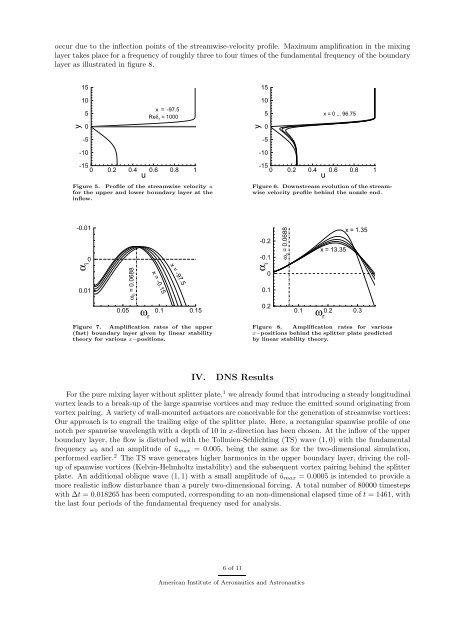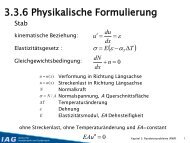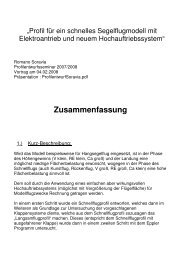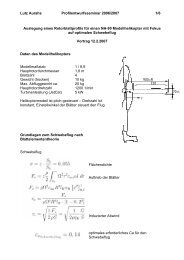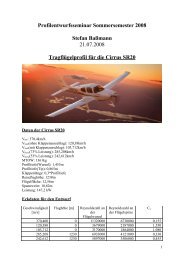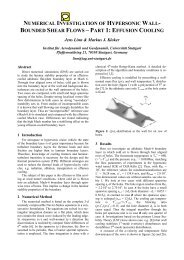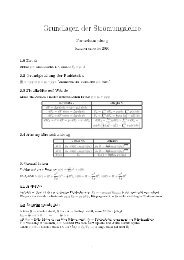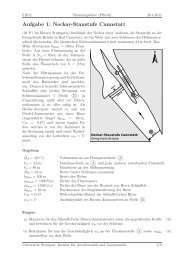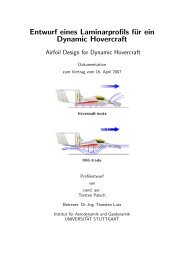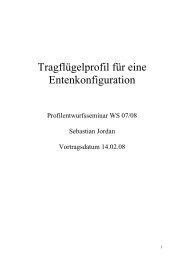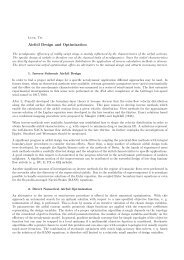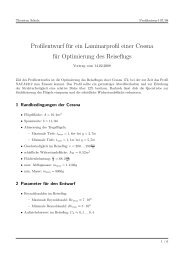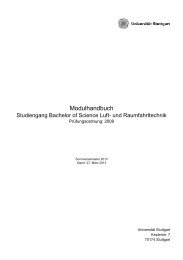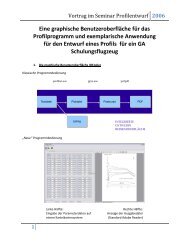pdf-File - IAG - Universität Stuttgart
pdf-File - IAG - Universität Stuttgart
pdf-File - IAG - Universität Stuttgart
Create successful ePaper yourself
Turn your PDF publications into a flip-book with our unique Google optimized e-Paper software.
occur due to the inflection points of the streamwise-velocity profile. Maximum amplification in the mixing<br />
layer takes place for a frequency of roughly three to four times of the fundamental frequency of the boundary<br />
layer as illustrated in figure 8.<br />
15<br />
15<br />
y<br />
10<br />
5<br />
0<br />
x = -97.5<br />
Reδ 1<br />
= 1000<br />
y<br />
10<br />
5<br />
0<br />
x = 0 ... 96.75<br />
-5<br />
-5<br />
-10<br />
-10<br />
-15<br />
0 0.2 0.4 0.6 0.8 1<br />
u<br />
Figure 5. Profile of the streamwise velocity u<br />
for the upper and lower boundary layer at the<br />
inflow.<br />
-15<br />
0 0.2 0.4 0.6 0.8 1<br />
u<br />
Figure 6. Downstream evolution of the streamwise<br />
velocity profile behind the nozzle end.<br />
-0.01<br />
0<br />
-0.2<br />
-0.1<br />
ω 0<br />
= 0.0688<br />
x = 1.35<br />
x = 13.35<br />
α i<br />
0.01<br />
ω 0<br />
= 0.0688<br />
x = -0.15<br />
x = -97.5<br />
α i<br />
0<br />
0.1<br />
0.05<br />
ω<br />
0.1 0.15<br />
r<br />
0.2<br />
0.1<br />
ω<br />
0.2 0.3<br />
r<br />
Figure 7. Amplification rates of the upper<br />
(fast) boundary layer given by linear stability<br />
theory for various x−positions.<br />
Figure 8. Amplification rates for various<br />
x−positions behind the splitter plate predicted<br />
by linear stability theory.<br />
IV. DNS Results<br />
For the pure mixing layer without splitter plate, 1 we already found that introducing a steady longitudinal<br />
vortex leads to a break-up of the large spanwise vortices and may reduce the emitted sound originating from<br />
vortex pairing. A variety of wall-mounted actuators are conceivable for the generation of streamwise vortices:<br />
Our approach is to engrail the trailing edge of the splitter plate. Here, a rectangular spanwise profile of one<br />
notch per spanwise wavelength with a depth of 10 in x-direction has been chosen. At the inflow of the upper<br />
boundary layer, the flow is disturbed with the Tollmien-Schlichting (TS) wave (1, 0) with the fundamental<br />
frequency ω 0 and an amplitude of û max = 0.005, being the same as for the two-dimensional simulation,<br />
performed earlier. 2 The TS wave generates higher harmonics in the upper boundary layer, driving the rollup<br />
of spanwise vortices (Kelvin-Helmholtz instability) and the subsequent vortex pairing behind the splitter<br />
plate. An additional oblique wave (1, 1) with a small amplitude of û max = 0.0005 is intended to provide a<br />
more realistic inflow disturbance than a purely two-dimensional forcing. A total number of 80000 timesteps<br />
with ∆t = 0.018265 has been computed, corresponding to an non-dimensional elapsed time of t = 1461, with<br />
the last four periods of the fundamental frequency used for analysis.<br />
6 of 11<br />
American Institute of Aeronautics and Astronautics


